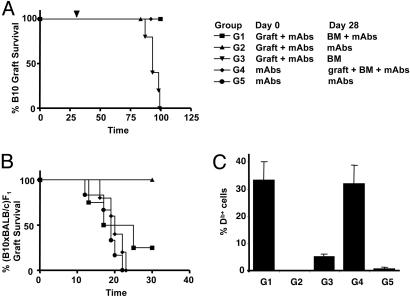Fig. 4.
Recessive transplantation tolerance induced with mAb treatment and donor BMT. (A) CBA mice were transplanted with B10 skin at day 0, and treated with nondepleting CD4, CD8, and CD154 mAbs, as described. One month after transplantation, at day 28, mice were treated with 4 × 107 T cell-depleted B10 BM cells under the cover of the same mAb treatment (G1: ▪, n = 5), mAbs alone (G2: ▴, n = 6), or BM alone (G3: ▾, n = 5). Different mice were treated initially with the mAbs in the absence of a skin graft, followed by a further treatment with mAbs at day 28 (G5: •, n = 6), or BM together with mAbs and a B10 skin graft (G4: ♦, n = 5; see treatment table in A). Group G2 (▴, MST = 93 days) was significantly different compared with all other grafted groups (MST >110 days); P < 0.001. (B) One hundred days after BM treatment, mice with surviving B10 skin grafts were transplanted with (B10×BALB/c)F1 skin. MST in days were: G1 = 21, G2 = >30, G4 = 20, and G5 = 19. Group G2 was significantly different to all other groups; P < 0.011. (C) All mice were bled 120 days after BMT to quantify the percentage of H2-Db+ T cells in their peripheral blood by flow cytometry.

